Hiatal hernia repair - series
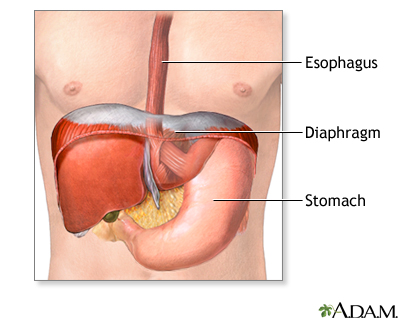
Normal anatomy
The esophagus runs through the diaphragm to the stomach. It functions to carry food from the mouth to the stomach. The esophagus passes through the diaphragm just before it meets the stomach, through an opening called the esophageal hiatus.
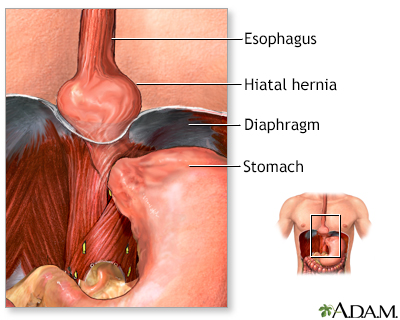
Indications
When the opening (hiatus) in the muscle between the abdomen and chest (diaphragm) is too large, some of the stomach can slip up into the chest cavity. This can cause heartburn (gastro-esophageal reflux; GER) as gastric acid backflows from the stomach into the esophagus. Hiatal hernia repair is surgery to repair a bulging of stomach tissue through the muscle between the abdomen and chest (diaphragm) into the chest (hiatal hernia).
Hiatal hernia repair may be recommended when the patient has:
- Severe heartburn
- Severe inflammation of the esophagus from the backflow of gastric fluid (reflux)
- Narrowing of the opening (hiatus) through the diaphragm (esophageal stricture)
- Chronic inflammation of the lungs (pneumonia) from frequent breathing in (aspiration) of gastric fluids
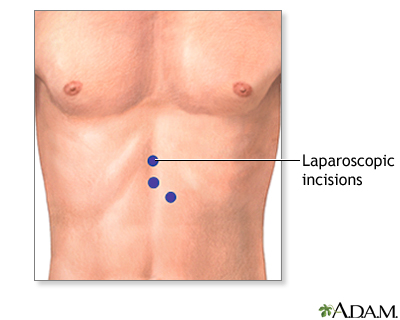
Incision
While the patient is deep asleep and pain-free (general anesthesia), an incision is made in the abdomen.
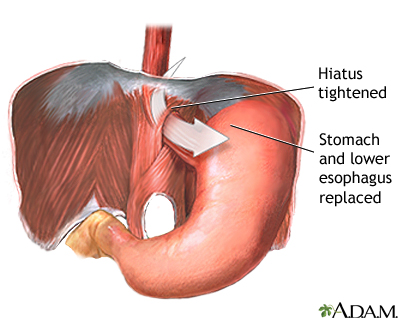
Procedure
The stomach and lower esophagus are placed back into the abdominal cavity. The opening in the diaphragm (hiatus) is tightened and the stomach is stitched in position to prevent reflux. The upper part of the stomach (fundus) may be wrapped around the esophagus (fundoplication) to reduce reflux.
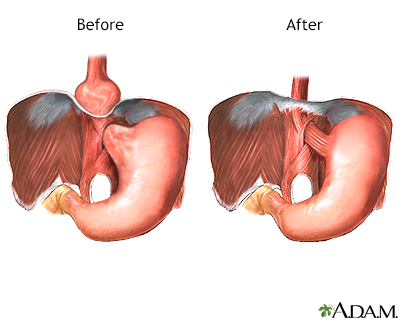
Aftercare
Patients may need to spend 3 to 10 days in the hospital after surgery. A tube will be placed into the stomach through the nose and throat (nasogastric tube) during surgery and may remain for a few days. Small, frequent feedings are recommended.
Related Information
Anti-reflux surgeryHiatal hernia
BACK TO TOP
Review Date: 11/25/2023
Reviewed By: Debra G. Wechter, MD, FACS, General Surgery Practice Specializing in Breast Cancer, Virginia Mason Medical Center, Seattle, WA. Also reviewed by David C. Dugdale, MD, Medical Director, Brenda Conaway, Editorial Director, and the A.D.A.M. Editorial team.

Health Content Provider
06/01/2025
|
A.D.A.M., Inc. is accredited by URAC, for Health Content Provider (www.urac.org). URAC's accreditation program is an independent audit to verify that A.D.A.M. follows rigorous standards of quality and accountability. A.D.A.M. is among the first to achieve this important distinction for online health information and services. Learn more about A.D.A.M.'s editorial policy, editorial process and privacy policy. A.D.A.M. is also a founding member of Hi-Ethics. This site complied with the HONcode standard for trustworthy health information from 1995 to 2022, after which HON (Health On the Net, a not-for-profit organization that promoted transparent and reliable health information online) was discontinued. |
The information provided herein should not be used during any medical emergency or for the diagnosis or treatment of any medical condition. A licensed medical professional should be consulted for diagnosis and treatment of any and all medical conditions. Links to other sites are provided for information only -- they do not constitute endorsements of those other sites. © 1997- 2025 A.D.A.M., a business unit of Ebix, Inc. Any duplication or distribution of the information contained herein is strictly prohibited.
